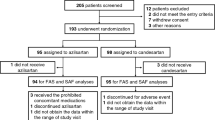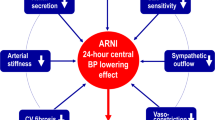Abstract
Left ventricular hypertrophy (LVH) is a powerful independent risk predictor for cardiovascular disease and reversal of LVH has become a primary goal of antihypertensive management. Recent evidence has confirmed that most hypertensive patients will benefit from a low-dose combination strategy to manage their hypertension, and two trials have recently examined the effect of this strategy on left ventricular mass. The REASON study (pREterax in regression of Arterial Stiffness in a contrOlled double-bliNd study) compared the low-dose combination of an angiotensin-converting enzyme (ACE) inhibitor and a diuretic with β-blocker monotherapy in hypertensive patients with LVH, and the PICXEL study (Preterax In a double-blind Controlled study versus Enalapril in LVH) compared the same low-dose combination with ACE inhibitor monotherapy in hypertensive patients with echocardiographic LVH. The REASON study demonstrated that the low-dose combination produced a significantly greater change in left ventricular mass after 1 year than the β-blocker, despite inducing a similar change in mean blood pressure. Additionally, perindopril/indapamide reduced central (carotid) and peripheral (brachial) systolic blood pressure (SBP) and pulse pressure (PP) to a significantly greater extent than β-blocker, and these benefits were more pronounced for the central values; LVH is affected more by central rather than peripheral haemodynamic changes. Results of the analysis of the PICXEL study showed a significantly greater decrease in LVH parameters and blood pressure over 1 year in favour of the low-dose combination. This reduction cannot be entirely explained by the better efficacy of the low-dose combination on blood pressure reduction.
This is a preview of subscription content, access via your institution
Access options
Subscribe to this journal
Receive 12 digital issues and online access to articles
$119.00 per year
only $9.92 per issue
Buy this article
- Purchase on Springer Link
- Instant access to full article PDF
Prices may be subject to local taxes which are calculated during checkout

Similar content being viewed by others
References
Guidelines Committee 2003. European Society of Hypertension–European Society of Cardiology Guidelines for the Management of Arterial Hypertension. J Hypertens 2003; 21: 1011–1053.
Chobanian AV et al the National High Blood Pressure Education Program Coordinating Committee. Seventh Report of the Joint National Committee on Prevention, Detection, Evaluation, and Treatment of High Blood Pressure. Hypertension 2003; 42: 1206–1252.
World Health Organization. 2003 World Health Organization (WHO)/International Society of Hypertension (ISH) statement on management of hypertension. J Hypertens 2003; 21: 1983–1992.
Verdecchia P et al. Prevalent influence of systolic over pulse pressure on left ventricular mass in essential hypertension. Eur Heart J 2002; 23: 658–665.
Levy D et al. Prognostic implications of echocardiographically determined left ventricular mass in the Framingham Heart Study. N Engl J Med 1990; 322: 1561–1566.
Devereux RB et al. Regression of left ventricular hypertrophy as a surrogate end-point for morbid events in hypertension treatment trials. J Hypertens Suppl 1996; 14: S95–S101.
Devereux RB et al. Prognostic significance of left ventricular mass change during treatment of hypertension. JAMA 2004; 292: 2350–2356.
Gosse P et al. Regression of left ventricular hypertrophy in hypertensive patients treated with indapamide SR 1.5 mg versus enalapril 20 mg: The LIVE study. J Hypertens 2000; 18: 1465–1475.
Klingbeil AU et al. A meta-analysis of the effects of treatment on left ventricular mass in essential hypertension. Am J Med 2003; 115: 41–46.
Dahlöf B, Pennert K, Hansson L . Reversal of left ventricular hypertrophy in hypertensive patients. A meta-analysis of 109 treatment studies. Am J Hypertens 1992; 5: 95–110.
Ganau A et al. Patterns of left ventricular hypertrophy and geometric remodelling in essential hypertension. J Am Coll Cardiol 1992; 19: 1550–1558.
Laurent S et al. Clinical benefits of perindopril/indapamide very-low-dose combination for hypertensive patients. J Hypertens 2001; 19(Suppl 4): S9–S14.
Mogensen CE et al. Effect of low-dose perindopril/indapamide on albuminuria in diabetes, Preterax in Albuminuria Regression: PREMIER. Hypertension 2003; 41: 1063–1071.
Chanudet W, De Champvallins M . Antihypertensive efficacy and tolerability of low-dose perindopril/indapamide combination compared with losartan in the treatment of essential hypertension. Int J Clin Pract 2001; 55: 233–239.
Morgan T, Anderson A . Low-dose combination therapy with perindopril and indapamide compared with irbesartan. Clin Drug Invest 2002; 22: 553–560.
Asmar RG et al on behalf of the REASON Project investigators. Amelioration of arterial properties with a perindopril–indapamide very-low-dose combination. J Hypertens 2001; 19(Suppl 4): S15–S20.
Asmar RG et al for the REASON Project coordinators and investigators. Improvement in blood pressure, arterial stiffness and wave reflections with a very-low-dose perindopril/indapamide combination in hypertensive patient, a comparison with atenolol. Hypertension 2001; 38: 922–926.
De Luca N et al on behalf of the REASON Project investigators. Selective reduction of cardiac mass and central blood pressure on low-dose combination perindopril/indapamide in hypertensive subjects. J Hypertens 2004; 22: 1623–1630.
London GM et al on behalf of the REASON Project investigators. Mechanism(s) of selective systolic blood pressure reduction after a low-dose combination of perindopril/indapamide in hypertensive subjects: comparison with atenolol. J Am Coll Cardiol 2004; 43: 92–99.
De Luca N et al on behalf of the REASON Project. Regression of left ventricular mass in hypertensive patients treated with perindopril/indapamide as a first-line combination. Am J Hypertens 2004; 17: 660–667.
Dahlöf B et al. The PICXEL study: benefit of perindopril/indapamide on LVH reduction. J Hypertens 2004; 22(Suppl 2): S410.
Gosse P et al. Efficacy of very low dose perindopril 2 mg/indapamide 0.625 mg combination on left ventricular hypertrophy in hypertensive patients: the PICXEL study rationale and design. J Hum Hypertens 2002; 16: 653–659.
Author information
Authors and Affiliations
Corresponding author
Rights and permissions
About this article
Cite this article
Dahlöf, B. Further evidence for low-dose combinations in patients with left ventricular hypertrophy. J Hum Hypertens 19 (Suppl 1), S9–S14 (2005). https://doi.org/10.1038/sj.jhh.1001887
Published:
Issue Date:
DOI: https://doi.org/10.1038/sj.jhh.1001887
Keywords
This article is cited by
-
Greater Regression of Electrocardiographic Left Ventricular Hypertrophy During Hydrochlorothiazide Therapy in Hypertensive Patients
American Journal of Hypertension (2010)



